
Messier 59 or M59, also known as NGC 4621, is an elliptical galaxy in the equatorial constellation of Virgo. It is a member of the Virgo Cluster, with the nearest fellow member 8′ away and around 5 magnitudes fainter. The nearest cluster member of comparable brightness is the lenticular galaxy NGC 4638, which is around 17′ away. It and the angularly nearby elliptical galaxy Messier 60 were both discovered by Johann Gottfried Koehler in April 1779 when observing comet seeming close by. Charles Messier listed both in the Messier Catalogue about three days after Koehler's discovery.
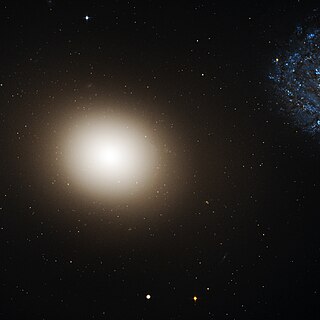
Messier 60 or M60, also known as NGC 4649, is an elliptical galaxy approximately 57 million light-years away in the equatorial constellation of Virgo. Together with NGC 4647, it forms a pair known as Arp 116. Messier 60 and nearby elliptical galaxy Messier 59 were discovered by Johann Gottfried Koehler in April 1779, observing a comet in the same part of the sky. Charles Messier added both to his catalogue about three days after this.
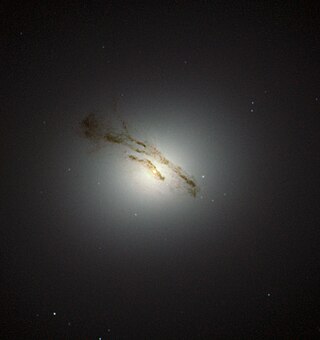
Messier 84 or M84, also known as NGC 4374, is a giant elliptical or lenticular galaxy in the constellation Virgo. Charles Messier discovered the object in 1781 in a systematic search for "nebulous objects" in the night sky. It is the 84th object in the Messier Catalogue and in the heavily populated core of the Virgo Cluster of galaxies, part of the local supercluster.

NGC 1427 is a low-luminosity elliptical galaxy located approximately 71 million light-years away from Earth. It was discovered by John Frederick William Herschel on November 28, 1837. It is a member of the Fornax Cluster. The galaxy has a stellar mass of 7.9 × 1010M☉, and a total mass of 9.4 × 1010M☉. However, the mass of the dark matter halo surrounding the galaxy is around 4.3 × 1012M☉.

NGC 4194, the Medusa merger, is a galaxy merger in the constellation Ursa Major about 128 million light-years (39.1 Mpc) away. It was discovered on April 2, 1791 by German-British astronomer William Herschel. Due to its disturbed appearance, it is object 160 in Halton Arp's 1966 Atlas of Peculiar Galaxies.

NGC 5962 is a spiral galaxy in the equatorial constellation of Serpens Caput. It was discovered by the Anglo-German astronomer William Herschel on March 21, 1784. The NGC 5962 galaxy is located at a distance of 120 million light years and is receding with a heliocentric radial velocity of 1,957 km/s. It is the brightest member of the eponymously-named NGC 5962 group, which overlaps with the nearby NGC 5970 group; the two groups may be gravitationally bound.

NGC 6340 is an unbarred spiral galaxy in the northern constellation of Draco. It was discovered by German-British astronomer William Herschel on June 6, 1788. The galaxy is located approximately 55 million light-years (17 Mpc) away, and is receding with a heliocentric radial velocity of 1,217 km/s. It is the largest member of a triplet of galaxies known as the NGC 6340 group.

NGC 4102 is an intermediate barred spiral galaxy located in the northern constellation of Ursa Major. It is visible in a small telescope and has an apparent visual magnitude of 11.2. The galaxy was discovered April 12, 1789 by William Herschel. J. L. E. Dreyer described it as "bright, pretty small, round, brighter middle and bright nucleus". This galaxy is located at a distance of 60 million light years and is receding with a heliocentric radial velocity of 837 km/s. It is a member of the Ursa Major group of galaxies.
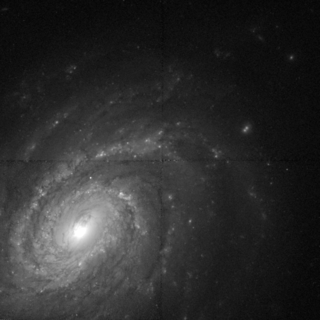
NGC 214 is a spiral galaxy in the northern constellation of Andromeda, located at a distance of 194 megalight-years from the Milky Way. It was discovered on September 10, 1784 by William Herschel. The shape of this galaxy is given by its morphological classification of SABbc, which indicates a weak bar-like structure (SAB) at the core and moderate to loosely-wound spiral arms (bc).

NGC 3610 is an elliptical galaxy in the constellation Ursa Major. It was discovered on 8 April 1793 by German-British astronomer William Herschel. This galaxy is located at a distance of 106 million light-years (32.5 Mpc) from the Milky Way, and is receding with a galacto-centric radial velocity of 1,819 km/s.

NGC 3311 is a super-giant elliptical galaxy located about 190 million light-years away in the constellation Hydra. The galaxy was discovered by astronomer John Herschel on March 30, 1835. NGC 3311 is the brightest member of the Hydra Cluster and forms a pair with NGC 3309 which along with NGC 3311, dominate the central region of the Hydra Cluster.

NGC 708 is an elliptical galaxy located 240 million light-years away in the constellation Andromeda and was discovered by astronomer William Herschel on September 21, 1786. It is classified as a cD galaxy and is the brightest member of Abell 262. NGC 708 is a weak FR I radio galaxy and is also classified as a type 2 Seyfert galaxy.
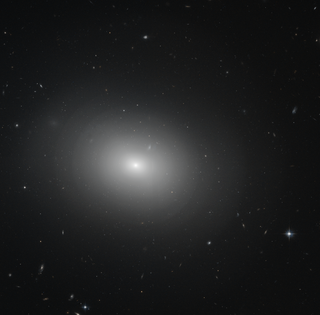
NGC 5982 is an elliptical galaxy located in the constellation Draco. It is located at a distance of circa 130 million light years from Earth, which, given its apparent dimensions, means that NGC 5982 is about 100,000 light years across. It was discovered by William Herschel on May 25, 1788.

NGC 4636 is an elliptical galaxy located in the constellation Virgo. It is a member of the NGC 4753 Group of galaxies, which is a member of the Virgo II Groups, a series of galaxies and galaxy clusters strung out from the southern edge of the Virgo Supercluster. It is located at a distance of about 55 million light years from Earth, which, given its apparent dimensions, means that NGC 4636 is about 105,000 light years across.

NGC 4061 is an elliptical galaxy located 310 light-years away in the constellation Coma Berenices. It was discovered by astronomer William Herschel on April 27, 1785. It was rediscovered by John Herschel on April 29, 1832. It is listed both as NGC 4061 and NGC 4055. NGC 4061 is a member of the NGC 4065 Group and forms an interacting pair with its companion, NGC 4065 as evidenced by distortions in their optical isophotes.

NGC 4302 is an edge-on spiral galaxy located about 55 million light-years away in the constellation Coma Berenices. It was discovered by astronomer William Herschel on April 8, 1784 and is a member of the Virgo Cluster.
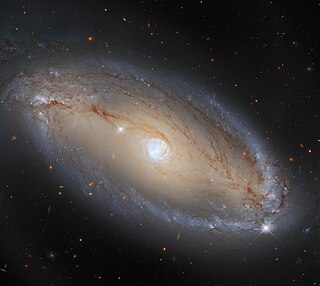
NGC 5728 is an active barred spiral galaxy located 146 million light years away in the southern constellation of Libra. It was discovered on May 7, 1787 by William Herschel. The designation comes from the New General Catalogue of J. L. E. Dreyer, published in 1888. It has an apparent visual magnitude of 13.40 and spans an angle of 3.4 arcminutes. The galaxy shows a red shift of 0.00935 and has a heliocentric radial velocity of 2,803 km/s. It has an estimated mass of 72 billion times the mass of the Sun and stretches around 30 kpc across.

NGC 1325 is a flocculent spiral galaxy situated in the constellation of Eridanus. Located about 75 million light years away, it is a member of the Eridanus cluster of galaxies, a cluster of about 200 galaxies. It was discovered by William Herschel on 19 December 1799.

NGC 4589 is an elliptical galaxy located in the Draco constellation. It was discovered by German-British astronomer William Herschel on November 22, 1797. This galaxy lies at a distance of 73.0 million light-years (22.39 Mpc) from the Milky Way, and is receding with a heliocentric radial velocity of 2,002 km/s. It is known by its designations PGC 42139 or UGC 7797.

NGC 959 is a spiral galaxy in the northern constellation of Triangulum. It was discovered on November 9, 1876, by French astronomer Édouard Stephan. This galaxy is located at a distance of 36 million light years and is receding with a heliocentric radial velocity of 596 km/s. It is a member of the NGC 1023 Group of galaxies.




















